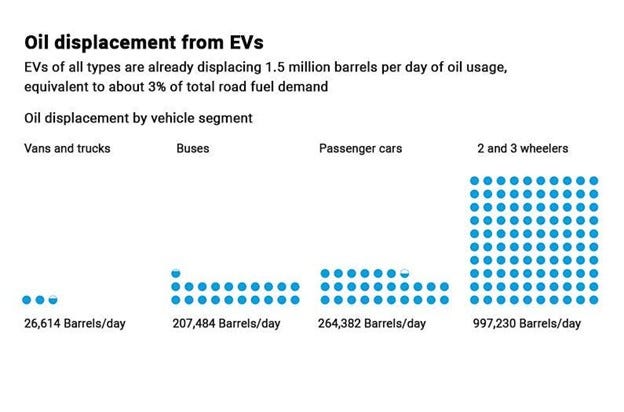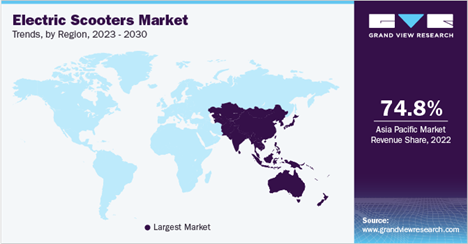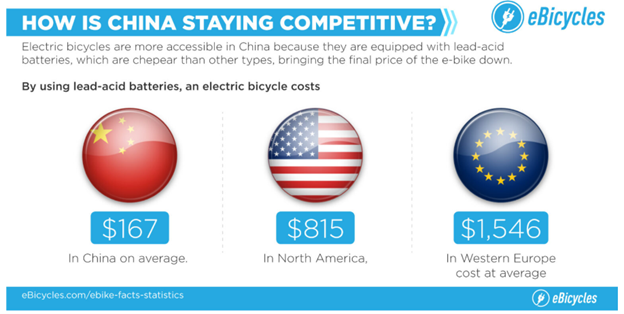The surprising reason the world is hitting peak oil demand faster than anyone thought
Bullets:
Global demand for oil will peak by 2030, and then decline. These estimates continue to be revised forward, as crude oil demand is being destroyed at a faster rate than expected.
The electrification of transportation systems is the primary driver. But by far the biggest destroyer of oil demand is the booming sales of electric bikes and scooters. E-bikes take twice as much oil off global markets as electric cars, trucks, buses, and trains--combined.
And it's not just in Asia. In North America and Europe, millions of electric bikes are sold every year, and almost all of them are displacing ICE-powered vehicles, instead of traditional bicycles.
Report:
The world is fast approaching peak oil demand. One the most important reasons is the transportation mix, away from internal combustion engine vehicles, to hybrid cars and electric vehicles. And that factor gets a lot of the headlines, because of the convulsive effects this has had on automakers in the US and Europe, who cannot build electric vehicles that are competitive with Chinese brands.
There’s another factor that may be even more important, though. It’s that electric bikes are booming, not only in the developing world—where it was expected—but also in Europe and North America. There are three key takeaways from the research here which we’ll lead with. Here’s the first one: electric bikes are cutting oil demand as much as all the electric cars, buses, and trucks, combined, times two. The energy efficiency of E-bikes is the internal combustion engine equivalent of 4,000 miles per gallon of gasoline.
Here’s the second surprise, from consumer surveys. E-bike customers are not buying them to replace bicycles, or because they’re faster than walking. They see the electric bike as a substitute for a car. Buyers of E-bikes cut their car trips by 37%. Half of all car trips in the US and around the world are under 3 miles, and two thirds are under 5 miles. Buyers of E-bikes are using them to make those trips. A study of E-bike owners in Sweden showed that all the Ebiking replaced car trips. The Swedes’ thinking is that it’s more convenient and faster to use an E-bike, than driving a short distance. And for every time they do that, it’s a hit to global oil demand.
As we go through these data, then, let’s remember that the motivation for the buyers of E-bikes is to replace car trips, not walking trips. And this is the third important data point: 90% of the world’s E-bike production comes from China. Chinese factories not only turn out the bulk of the world’s electric passenger vehicles and trucks, but they also make almost all the electric bikes. Over the four years from 2020 through 2023, about 130 million electric bikes were sold worldwide, so make that about 110 million E-bikes built in China, sold over 4 years.
In the United States, the sales of electric bikes is growing much faster than for regular bikes. Overall bicycle sales in the US were up 65% in 2019 and 2020, but it was electric bikes, growing at 145%, that drove most of that.
The above is a forecast for the rest of this decade, worldwide. For the US market, they anticipate industry growth of 13.3% per year through 2030, that’s in the United States. The largest market will continue to be Asia, ASEAN, and Australia, which will be three fourths of the global market.
Here is the kind of chart we should be used to, by now: Remember, China makes 90% of all the E-bikes in the world. Most of the bikes sold in the US and Europe are made here, in China, and just white-labeled at much higher cost. In China and India and other neighboring countries, E-bikes just don’t cost very much.
But they’re selling very well anyway in Europe and North America, because the buyers are not substituting E-bikes for bikes, they’re replacing cars. In the Netherlands and in Germany, E-bikes now outsell regular bicycles. In Germany, there are 11 million E-bikes, seven times the level of a decade ago.
In Europe, some countries subsidize the purchase of electric bike buyers, and in France the subside is up to 2,000 euro. And that explains the cost outlier a bit better—European retailers are simply marking up the costs of electric bikes to match what the government is giving away to buy them.
In Belgium they allow for much faster E-bikes than elsewhere, up to 28 miles per hour, and the leading consumer segment is city and commuter travel—again, displacing cars and public transportation, the biggest demand is for people going to work and running errands.
In Austria, 75% of bikes sold are electric bikes. In Poland E-bikes is now a billion dollar industry.
A couple of points here, from the perspective of a guy who sees a million of these things zipping around every time I go outside. They are everywhere, here. And what they do is solve the last-mile problem, better than cars or trucks. Delivery companies in China, India, and most places here on this map—their logistics systems work differently. Almost everything gets delivered by E-bike. Big trucks are used between major distribution hubs and local warehouses, then E-bike drivers load up there, and deliver product. The E-bikes make deliveries faster, and make point-to-point deliveries possible in a way that trucks or cars simply cannot, in big cities, while pushing down the cost. And that’s what’s coming to cities everywhere, eventually.
I’ve got an issue too, just a minor point of disagreement, as to how these data here are presented in these research pieces. I get that E-bikes are bikes, and buyers go to a bicycle shop to buy them and get them repaired. But we should probably be looking at these E-bike sales a different way. E-bikes are not cannibalizing sales of bicycles; customers aren’t looking at bicycles and comparing with electric bikes, then choosing the E-bike. They’re choosing electric bikes over cars.
That’s the metric we SHOULD be using. A bike shop in Europe or the US who offers electric bikes doesn’t have to worry about lost sales on the old-fashioned kind where you move your legs. It’s the car dealership next door to the bike shop that’s losing a customer. And it’s the oil companies that was expecting to see him fill up his tank a couple of times a month, and now won’t be seeing him at all. So we are hitting peak oil demand a lot sooner than anyone thought.
Resources and Links:
How EVs Will Drive Peak Oil This Decade, in Five Charts
https://about.bnef.com/blog/how-evs-will-drive-peak-oil-this-decade-in-five-charts/
How many wheels should your next EV have?
https://www.anthropocenemagazine.org/2023/08/how-many-wheels-should-your-next-ev-have/
Electric bike sales around the world pass key milestones
https://www.cyclingelectric.com/in-depth/electric-bike-sales-around-the-world-pass-key-milestones
Electric Bicycle Market Insights From Industry Experts
https://www.peopleforbikes.org/news/electric-bicycle-market-insights-2024
E-Bike Facts & Statistics for 2025
https://www.ebicycles.com/ebike-facts-statistics/
Electric bike sales grew by 145% in the US last year - here’s why that matters
https://www.weforum.org/stories/2021/03/electric-bicycles-sales-growth/
BCC Research: Top 5 Players in the Global E-Bike Market
https://blog.bccresearch.com/top-5-players-in-the-global-e-bike-industry
Electric Scooters Market Size, Share & Trends Analysis Report By Battery (Lithium-ion, Lead-acid), By Drive Type (Belt Drive, Hub Motor), By End-use (Personal, Commercial), By Region, And Segment Forecasts, 2024 - 2030
https://www.grandviewresearch.com/industry-analysis/electric-scooters-market






Spot on. Living in rural Thailand where nearly every 6 year old rides an ebike to school. Parents ditching the old diesel SUV for a more economical Chinese EV. Meanwhile foreign auto companies like Toyota, Mitsubishi, and Isuzu beg the Thai government for bailouts.
>> Global demand for oil will peak by 2030, and then decline. These estimates continue to be revised forward.....
There is another group of expert estimates, about 'a Little Ice Age associated with Grand Solar Minimum,' that is supposed to reach its apex between 2031 and 2043. Depending on how true they are, the global demand for oil may peak a decade or so later.
Links to sources :
https://www.researchgate.net/post/Modern_Grand_Solar_Minimum_2020-2053_Will_Modern_GSM_counterpoise_the_signs_of_global_warming_for_the_next_three_decades
https://solargsm.com/
https://www.youtube.com/watch?v=SawIG4TNpHQ